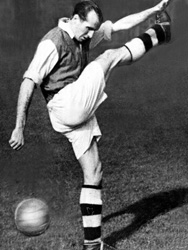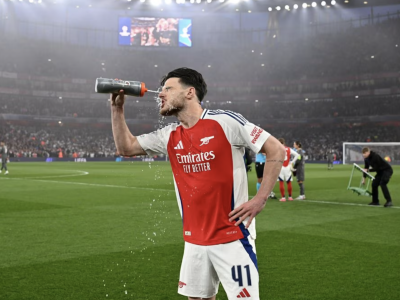For the first part of the twentieth century, the First Division and FA Cup Double remained an elusive and seemingly impossible dream for all sides. It was first achieved in the inaugural Football League Season of 1888/89 by Preston North End, followed by Aston Villa in 1897. The First Division, however, consisted of twelve sides in 1889 and sixteen in 1897. By the time the top division had extended to twenty-two sides by the end of the First World War, winning both the League and the FA Cup – the only two major honours in Football at this time – in the same season had seemed like a bridge too far.
By 1931 Arsenal had won the League and FA Cup in back-to-back seasons. By the start of the 1931/32 season, much of the talk within the club and the National Press had been whether Arsenal, with their growing dominance over the English game, could pull off the elusive double. Arsenal, however, kicked off their season with a 0-1 defeat at home to West Brom and also failed to win their following three games. From then on, they were playing catch-up in order to close the gap at the top. Former Arsenal player and journalist, Bernard Joy, the author of ‘Forward Arsenal’, attributes the poor start to the side being over-confident, pushing forward too eagerly and leaving too many holes for the counter-attack. By mid-February, a 4-0 home win over Grimsby had put them within a point of the top of the table with a game in hand. They were also progressing in the FA Cup. However at the end of March came injury to their playmaker, Alex James, against West Ham. That was followed by a failure to win in six of the following seven league matches.
In between that run of fixtures came the FA Cup Final on April 23rd 1932 against Newcastle United. Tom Whittaker had worked around the clock to get Alex James fit, as seen from this Pathé News footage (along with some very 1930s humour from Joe Hulme, which may sound a bit suspect to 21st Century ears!). Arsenal spent the week before the game preparing in Brighton, where James had been given a fitness test, which he came through. Trainer Tom Whittaker, however, in order to be certain, lunged at ‘Wee Alec’ with a fierce tackle, which he was unable to withstand and from which he came away hobbling.
In the final itself Arsenal went a goal up through Bob John. However, Newcastle pulled one back through a controversial equaliser, of which Movietone News Footage had proven that the ball had crossed the dead ball line before Newcastle winger Jimmy Richardson crossed for Jack Allen to head the equaliser. Allen went on to score another with the Magpies taking the Cup in a 2-1 victory. They became the first side to win a Wembley final after going a goal behind. According to Brian Glanville in his 1952 book on the history of Arsenal, however, ‘There probably would not have been much doubt about this ‘over the line’ final had Alex James proved fit, such was the extent to which Arsenal relied upon and trusted in him’.
After the deflation of losing the FA Cup, Arsenal needed to pick themselves up to carry on the fight for the League title for the remaining fixtures and claw back the six-point deficit which had accumulated. Despite winning their last three matches, the title went to the Dixie Dean-inspired Everton, who had only been promoted back to the top division a season earlier. Arsenal bounced back from this season of disappointment to win a hat-trick of league titles and also dominate English football throughout the 1930s. No League and FA Cup double was forthcoming, however, though the opportunity arose again in the 1951/52 season when they were just three matches away from completing this elusive feat. It was in the 1930s when the club attained the nickname ‘Lucky Arsenal’. Luck, however could not have been said to have been in abundance in their 1951/52 campaign.
It was a ground-breaking year for the Arsenal as Highbury, newly installed with floodlights, had hosted prestigious friendlies against Hapoel Tel Aviv in September, where Arsenal ran out 6-1 winners, and a month later against Scottish Champions, Rangers, whom they beat 3-2. Floodlit football however was not to be permitted by the Football League for League fixtures until 1956. As Arsenal progressed in the FA Cup as well as having to postpone fixtures due to snow, they were unable to play midweek fixtures during the winter months and, as a result, they were faced with a fixture backlog by April. After beating Chelsea in the Semi-Final replay, two days after their first meeting, they were then required to play eight league games in seventeen days in order to complete their league fixtures, three of which were played over the Easter Weekend alone.
The effect of this took its toll on the Arsenal side. Against Blackpool on Good Friday, centre-half Ray Daniel broke his wrist. The next day full-back Lionel Smith wrenched his knee at Bolton. Arsenal’s league hopes were effectively ended on a Monday evening in the penultimate fixture at West Brom in a 3-1 defeat. The final fixture of the season was to be away at Matt Busby’s Manchester United, who were the league leaders. Arsenal could only seal the title on goal average with a win of seven clear goals. United ended up trouncing an exhausted Arsenal 6-1. Even the pride of coming second in the League was to elude the Arsenal, as they were pipped to the runners-up spot on goal-average by Tottenham Hotspur’s ‘Push and Run’ side, who had won the first of their only two league titles they have ever achieved, twelve months prior.
Arsenal never came out of the final fixture unscathed on the injury front either, losing centre-half Arthur Shaw to a fractured wrist. As a result, Ray Daniel was called up on the eve of the final to play with his arm in plaster. In response, he stated bluntly that ‘if we win the Cup tomorrow they can break my arm in four places for all I care’. Inside Forward Jimmy Logie had also been hospitalised one week prior to the final but also turned out. In the final itself, again up against Newcastle, full-back Wally Barnes was stretchered off after 35 minutes, badly twisting his knee in a tackle with George Robledo, which put him out of action for the whole of the following season’s campaign.
Ten-man Arsenal carried on with outside-left Don Roper acting as a makeshift right-back. A ‘backs-to-the-wall’ performance followed. However, eleven minutes from time, Doug Lishman went close to putting Arsenal ahead, skimming the bar with a header. Five minutes later came the fatal blow. Cliff Holton and Don Roper had both gone down injured; while captain Joe Mercer had been remonstrating with the referee to allow treatment for the two injured Arsenal players, Chilean international George Robledo headed Newcastle into the lead. Arsenal were to have one last chance however from Alex Forbes which hit the bar. The Cup went to the North-East for the second successive season, the first side in the 20th century to retain the FA Cup.
Though beaten, Arsenal gained a huge amount of respect from the neutrals for their performance. At the traditional post-match banquet, Joe Mercer stated that ‘I thought Football’s greatest honour was to captain England. I was wrong. It was to captain Arsenal today’. Brian Glanville, in his 1952 book, had stated that the 1951/52 season was ‘in every way an epic season for the Gunners, and even the most disappointed of supporters could take courage in the certainty that there would be many, many more to come’. In the short term, that wasn’t entirely the case; however, the team-spirit fostered toward the end of that season in no doubt went someway to their capturing the League Championship title, a record eighth, twelve months later, pipping Preston North End to the title on goal average with a 3-2 win over Burnley in the final game of the season.
After the 1953 title success, there followed a seventeen-year wait for another trophy, until 1970 under Bertie Mee, when Arsenal won the Fairs Cup in front of an ecstatic Highbury crowd. Arsenal were also to finally achieve the double twelve months later at Wembley. However, by this time, the dream of becoming the first side in modern times to achieve the League and FA Cup double had gone. That honour went up the other end of the Seven Sisters Road in 1961, to Bill Nicholson’s Tottenham Hotspur, sixty-four years after Aston Villa last performed that feat. However, unlike Spurs, Arsenal can at least take comfort in the fact that neither leg of Tottenham’s double was secured at Highbury, that our achievements were captured in glorious Technicolor, and that 1971 was not to be our one and only double success.
*Follow me on Twitter@robert_exley







